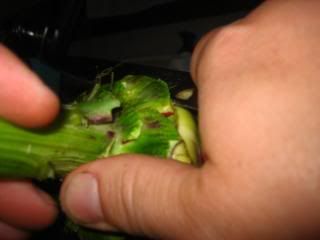
During my trip to northern Italy last fall, I was introduced to a pasta from the area around Mantova called Caponsei. It's a very soft, delicate fresh pasta similar to Gnocchi, but made with bread crumbs instead of potato. I have searched for a recipe for over a year, but have not been able to come up with anything close to those we got at the little pasta shop in downtown Peschiera del Garda. Just before Thanksgiving, Sirius satelite radio's Martha Stewart channel conducted their annual helpline with celebrity chef's available to answer questions from the audience. I noticed on the schedule that Lidia Bastianich would be on, and considering her pasta prowess and northern Italian heritage I thought she might be the person to help me out. I called in and described Caponsei to her and although she did not know this particular pasta (the name might be a local dialect), she did suggest to me the following recipe for bread gnocchi. I tried it out, and while probably not authentic Caponsei, it is very similar and tasty. Thanks Lidia for the "off the top of your head" recipe, and I hope you won't mind me sharing it here. I certainly give you full credit.
As for people reading this, if you have never made fresh pasta before and are a little intimidated by the thought of it, this is just about the easiest fresh pasta on earth. It requires no special tools, there is very little flour in it so you don't have to worry about kneading it to get the gluten just right, and the only skill required to form the gnocchi are the same ones you used in kindergarten to make things out of Play-Doh.
2 cups fresh bread crumbs (see below)
1/4 cup milk
1/3 cup flour
1/2 cup grated Parmigiano Reggiano
1 handful fresh chopped parsley salt, pepper, fresh nutmeg to taste
1 large egg
To start, make fresh bread crumbs by taking some good quality, day old bread (in this case I had left over baguette slices from our holiday party).

Trim the crusts and put aside for croutons, bread crumbs or bird feeding

Cut the bread into 1/4 inch cubes

Pulse briefly in a food processor until they are a relatively uniform crumb

Add milk, cheese, parsley and spices to taste (it should be aggressively flavored)

Add one beaten egg and toss lightly with a fork until just barely incorporated

Take one teaspoon of the mixture and drop onto a floured board; roll lightly to coat with flour

Lighty roll between the palms of your hand, meatball style

Being careful not to compact too much, form a small ball about the size of a cherry tomato

Next, roll the ball back and forth across your palm with the tips of your fingers to form a small football shaped pasta

The finished pasta should look like this

Roll lightly in flour to coat and prevent the pasta from sticking to each other

When ready to cook, bring a large pot of salted water to a boil, add the pasta and cook until they just begin to float
Remove with a spider and sauce in your preferred manner. Traditional sauces include melted butter with sage, simple tomato sauce or in this case a gorgonzola cream sauce.




































